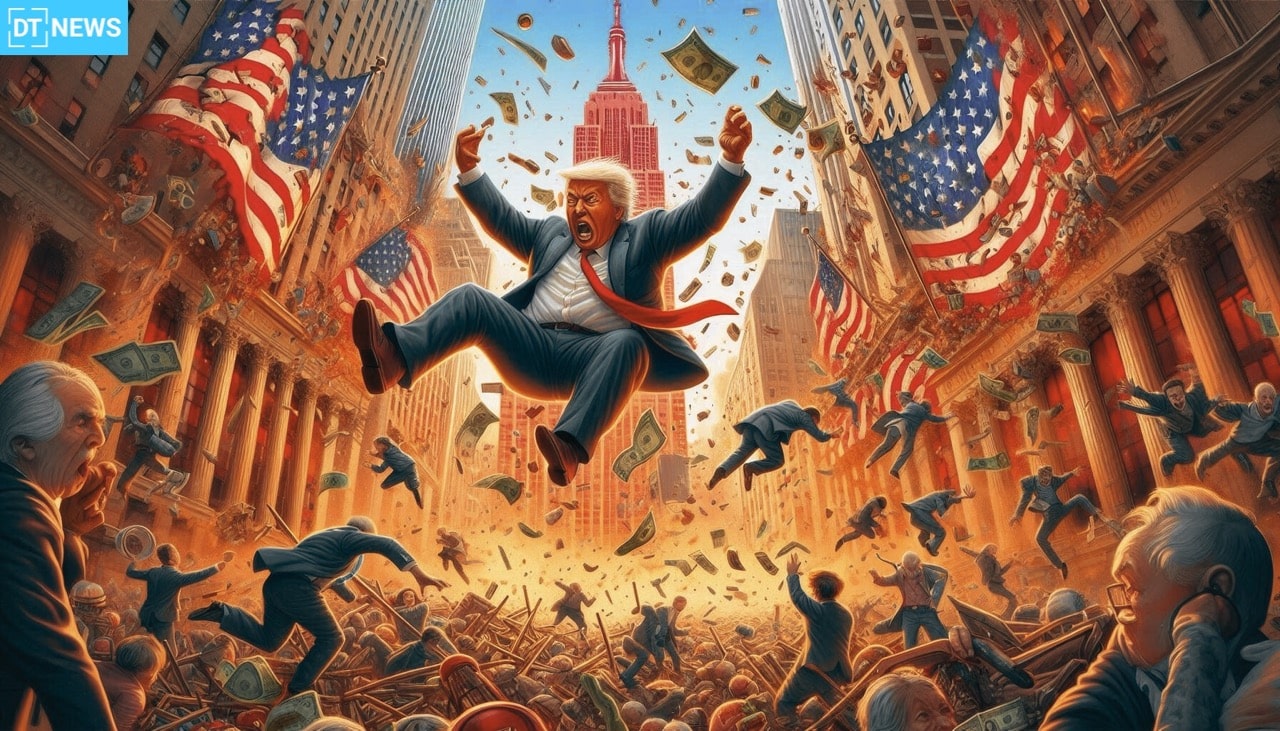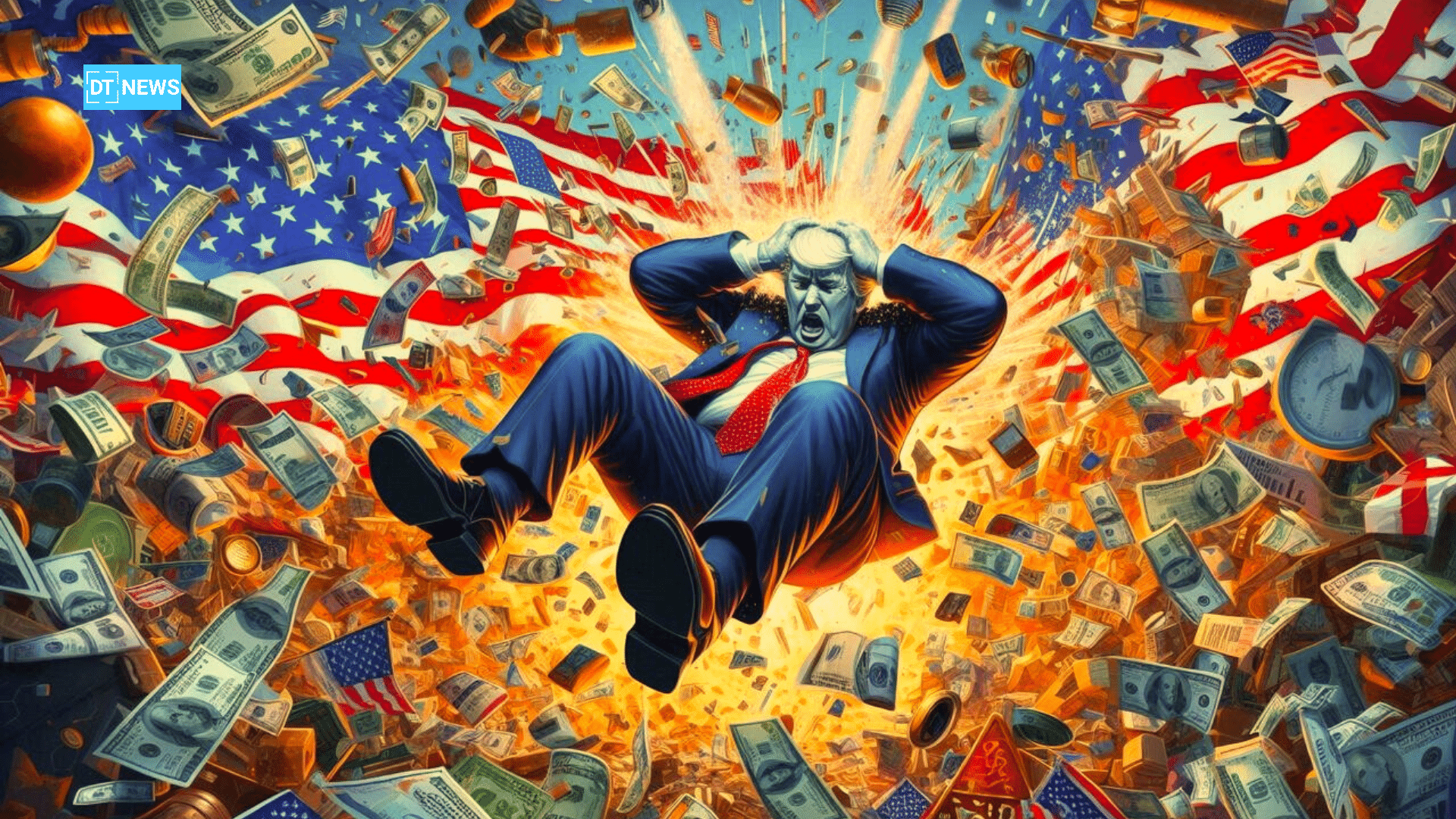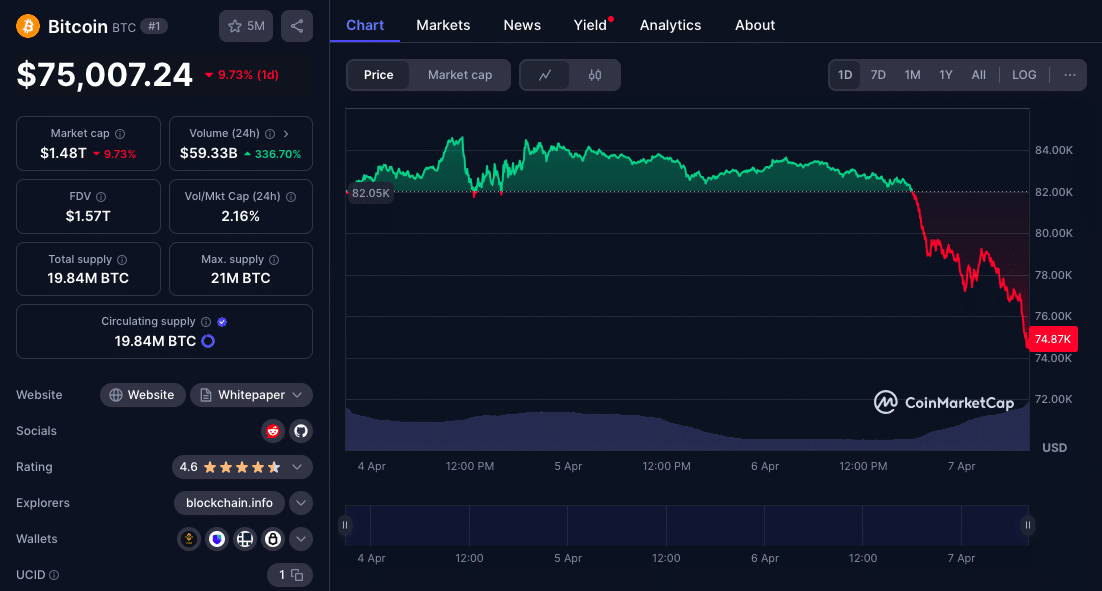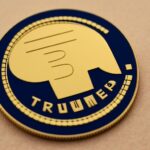According to market sources, the US stock market has lost an astonishing $11 trillion since February 19, with a staggering loss of $3.25 trillion in a single day on April 4, its worst trading day since the COVID crash in March 2020. Analysts now think recession fears are back this time around. At the heart of it all is Donald Trump’s tariff policy, which he just reintroduced weeks after re-entering the White House.
- Tariffs Roil Confidence, Send Recession Odds Over 60%
- Nasdaq in Bear Market as Volatility Returns with Force
- Did Bitcoin Hold Ground Amid Market Bloodbath?
- Is the Trump Administration Engineering a Crisis?
- The Fed’s Next Move is Now in Focus.
- Wrap-Up: A Test for U.S. Markets and Monetary Policy
- Glossary
The tech sector took the brunt of the market carnage. Tesla plummeted by 10.42%, Nvidia lost 7.36% and Apple shed 7.29%; according to TradingView. The Nasdaq 100 dropped 6%, officially putting the index into bear market territory, a decline of at least 20% from its recent highs.
April 4’s selloff alone reportedly erased more value than the entire cryptocurrency market is currently worth. At $3.25 trillion in losses, it dwarfed the total crypto market cap of $2.68 trillion. This gives an idea of just how far sentiment has fallen.
Tariffs Roil Confidence, Send Recession Odds Over 60%
The financial advisory platform The Kobeissi Letter described April 4 as the worst trading day for US equities since the COVID crash.
“US stocks have now erased a massive $11 trillion since February 19,” it said. “Recession odds now exceed 60%.”
Just two days earlier, President Trump signed an executive order imposing a 10% baseline tariff on all imports and introducing reciprocal tariffs targeting countries with unfavorable trade terms.
“We will no longer accept trade theft disguised as globalization,” he said during a press briefing. “Every nation will be held to fair terms or face equal consequences.”
Markets didn’t take that announcement lightly. Within 48 hours, equities began to unravel at a tumbling pace, a sign investors are deeply skeptical about the economic implications of those blanket tariffs.

Nasdaq in Bear Market as Volatility Returns with Force
Officials say, Nasdaq is now in bear market territory, and volatility has spiked to levels unseen since 2022. Tech stocks, which had been driving bull market momentum, are particularly vulnerable as investors reprice growth expectations amid fears of global trade disruption.
“Policy unpredictability is causing the blowback,” said Seema Shah, Chief Global Strategist at Principal Asset Management. “Markets aren’t just reacting to tariffs—they’re reacting to what tariffs signal: confrontation, uncertainty and economic drag.”
Experts believe the Nasdaq drop into bear territory is more than just technical, it’s a warning sign for institutional investors managing trillions in equities. As of April 5, the index had shed 23.4% from its January peak and there’s little technical support in sight.
Did Bitcoin Hold Ground Amid Market Bloodbath?
During the immediate market reactions, Bitcoin held its ground as the market went up in flames. This a pretty interesting contrast. However at the time of writing, it is trading at around $75K, down by 9.73% in the last 24 hours, according to CoinMarketCap. This raises questions, could the bear effect be sweeping into Bitcoin now, is BTC finally succumbing to the storm?
Some market observers saw the earlier resilience as a sign of growing interest in alternative hedges.
“Bitcoin doesn’t care about tariff wars or markets tanking,” says technical analyst Urkel on X. “It just keeps on doing its own thing—and that’s quietly impressive.”
Even former skeptics took note. Stock commentator Dividend Hero, who’s been pretty vocal in his criticism of crypto, wrote:
“I’ve hated on Bitcoin in the past, but seeing it hold steady while stocks collapse is very interesting to me. That’s a pretty big deal.”
Is the Trump Administration Engineering a Crisis?
This is a question on a lot of people’s minds right now. Bitcoin advocate and media personality Anthony Pompliano thinks Trump may be deliberately triggering market stress to pressure the Federal Reserve into slashing interest rates.
“Trump and his team are crashing the market on purpose,” Pompliano wrote. “Is this a master plan or just uncontrolled destruction?”
He floated that theory on his Pomp Podcast, arguing that Trump’s administration, particularly Treasury Secretary Scott Bessent, is trying to create conditions that force Fed Chair Jerome Powell into a corner.
“That’s the only way they can refinance $7 trillion in upcoming debt without collapsing the fiscal house of cards.”
This claim is speculative, but it echoes broader investor concerns that politics are taking precedence over long-term economic strategy.
The Fed’s Next Move is Now in Focus.
Despite Trump’s calls for rate cuts, the Fed held interest rates steady at 4.25%-4.5% in January. Chairman Powell has stuck to his cautious approach amid lingering inflationary pressures.
But the latest market turmoil may just force a change of heart. ‘According to CME FedWatch data, traders are now pricing in a 64% probability of a rate cut by July, up from 39% just a’ week earlier.
“The Fed doesn’t want to look like it’s responding to political pressure,” says Diane Swonk, Chief Economist at KPMG. “But the economic data and market volatility may give them an off-ramp.”
Whether Powell sticks to his guns or bends to market and political realities will likely determine the next leg for both equity and crypto markets.
Wrap-Up: A Test for U.S. Markets and Monetary Policy
The $11 trillion market drop caused by Trump’s tariff blitz is more than just volatility, it’s a reckoning. Investors are questioning the sustainability of U.S. stocks in a new era of protectionism and global tension.
With recession odds rising, tech stocks plummeting, and political pressure mounting on the Fed, this may be the moment that defines the U.S. economy in 2025 and beyond. The’ next few months will test not only the markets but the resolve of policymakers navigating an increasingly wild global financial system.
FAQs
Why did U.S. stocks lose $11 trillion?
The losses were reportedly caused by ‘President Trump’s new tariffs, which scared the world into a global trade war and recession.
Which companies were hit the hardest?
Tesla, Nvidia, and Apple were the biggest losers among the “Magnificent 7” tech stocks, each down 7-10%.
Will the Federal Reserve cut rates?
Market expectations for a rate cut have increased after the stock plunge, but the Fed has not committed to one.
What is Anthony Pompliano’s theory about the Trump administration?
Pompliano thinks Trump is intentionally crashing the markets to get the Fed to cut rates before the U.S. has a debt crisis.
Glossary
Bear Market: A market where prices fall 20% or more from recent highs, indicating negative sentiment.
Tariff: A tax on imported goods ‘to protect domestic industries or correct trade imbalances.
Recession: A period of economic decline marked by reduced GDP, employment, and consumer spending.
Rate Cut: A reduction in interest rates by a central ‘bank to stimulate the economy.
Volatility Index (VIX): A measure of market expectations’ for near-term price changes, often called the “fear gauge.”




















































































































